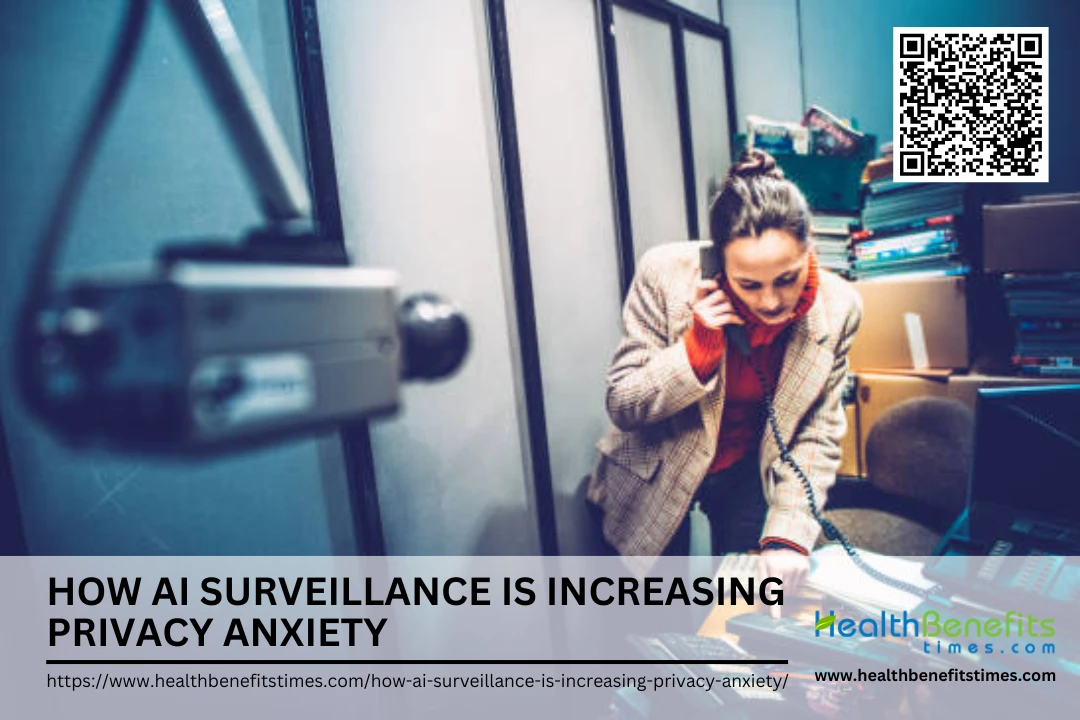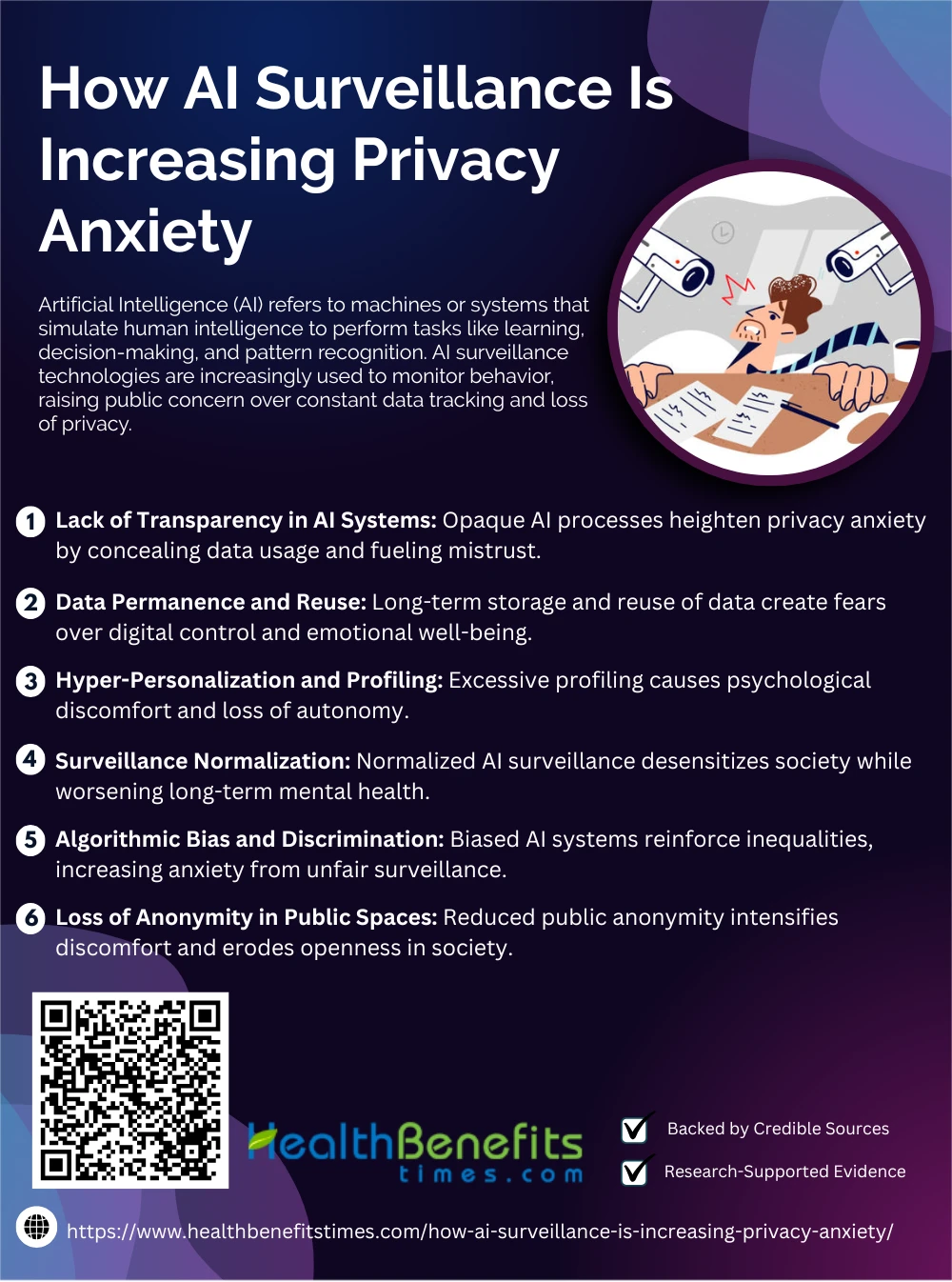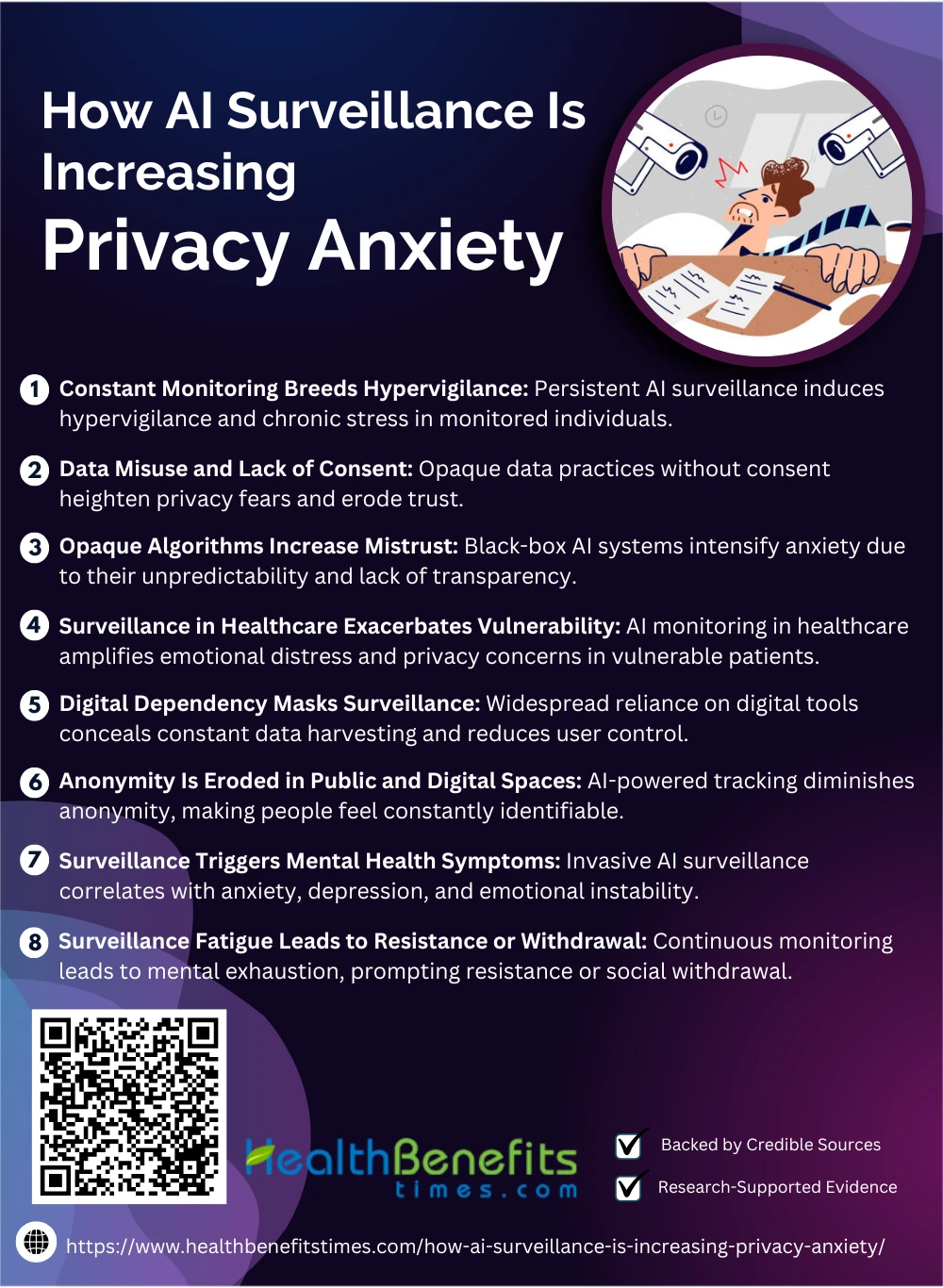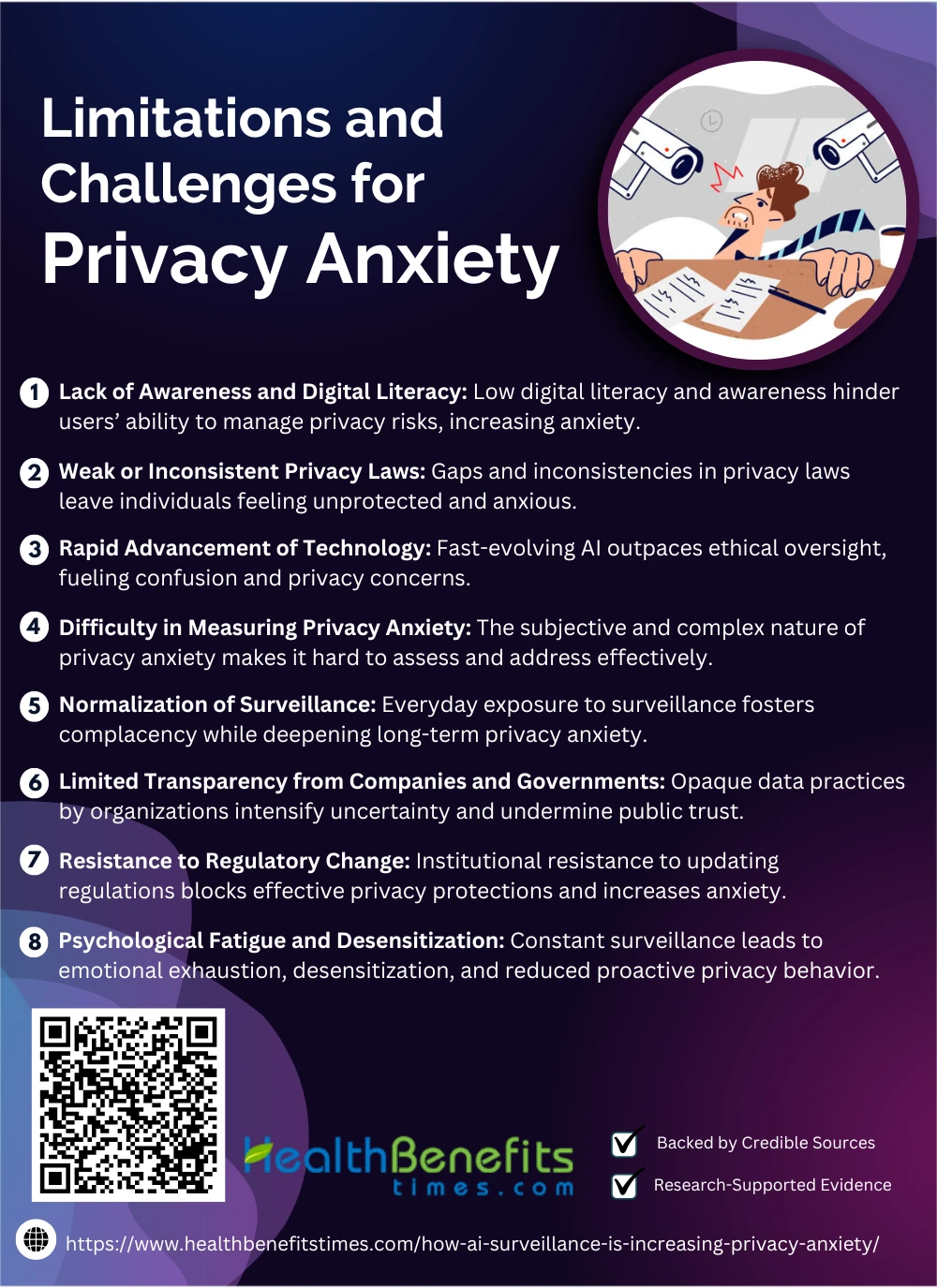- Artificial Intelligence (AI) refers to machines or systems that simulate human intelligence to perform tasks like learning, decision-making, and pattern recognition.
- AI surveillance technologies are increasingly used to monitor behavior, raising public concern over constant data tracking and loss of privacy.
- The growing use of AI in public and private spaces is fueling anxiety about personal freedom, autonomy, and digital safety.
 Anxiety is a psychological and physiological response to perceived threats, often manifesting as heightened worry, nervousness, or unease about future uncertainties. It can significantly impact well-being, particularly when persistent or triggered by environmental stressors. As artificial intelligence becomes an increasingly integral component of modern surveillance systems, public unease surrounding data privacy and personal freedom is rising sharply. AI surveillance — from facial recognition and biometric tracking to predictive policing — is now embedded in everyday life, often without individuals’ informed consent. Research shows that this type of omnipresent monitoring contributes directly to rising levels of privacy-related anxiety. Individuals report a growing sense of vulnerability and behavioral self-censorship due to the fear of being constantly observed. This phenomenon is not just emotional but backed by empirical studies; for instance, researchers at the University of California found that awareness of AI surveillance significantly correlates with reduced trust and higher psychological stress levels. Furthermore, surveillance practices powered by AI have been criticized for disproportionately affecting marginalized communities, heightening anxieties among already vulnerable groups. As a result, AI surveillance is no longer seen as a neutral technological evolution—it has become a powerful societal force shaping emotional and psychological well-being.
Anxiety is a psychological and physiological response to perceived threats, often manifesting as heightened worry, nervousness, or unease about future uncertainties. It can significantly impact well-being, particularly when persistent or triggered by environmental stressors. As artificial intelligence becomes an increasingly integral component of modern surveillance systems, public unease surrounding data privacy and personal freedom is rising sharply. AI surveillance — from facial recognition and biometric tracking to predictive policing — is now embedded in everyday life, often without individuals’ informed consent. Research shows that this type of omnipresent monitoring contributes directly to rising levels of privacy-related anxiety. Individuals report a growing sense of vulnerability and behavioral self-censorship due to the fear of being constantly observed. This phenomenon is not just emotional but backed by empirical studies; for instance, researchers at the University of California found that awareness of AI surveillance significantly correlates with reduced trust and higher psychological stress levels. Furthermore, surveillance practices powered by AI have been criticized for disproportionately affecting marginalized communities, heightening anxieties among already vulnerable groups. As a result, AI surveillance is no longer seen as a neutral technological evolution—it has become a powerful societal force shaping emotional and psychological well-being.
The Rise of AI Surveillance
AI surveillance encompasses a range of technologies designed to monitor, analyze, and often predict human behavior. These include facial recognition systems, gait analysis, emotion recognition, and predictive policing algorithms. Some systems also utilize natural language processing to monitor communications and thermal imaging for crowd tracking.
These technologies are widely adopted across key sectors. In law enforcement, AI tools assist in crime prediction and suspect identification. The retail industry uses facial and behavioral analytics to personalize customer experiences and reduce theft. Employers deploy AI for productivity tracking and workplace surveillance, while governments integrate such systems into smart city infrastructure.
Real-world deployments reveal both innovation and controversy. For example, China’s expansive use of facial recognition for social credit scoring has sparked global concern. Similarly, the U.S. saw backlash against Clearview AI’s unauthorized image harvesting.
Privacy Anxiety: What It Is and Why It’s Growing
Privacy anxiety is a growing psychological phenomenon marked by persistent stress and fear stemming from the perception that one’s personal data or behaviors are being monitored, recorded, or misused. Research in psychology links this anxiety to heightened levels of stress, reduced autonomy, and even self-censorship in digital environments. Unlike traditional surveillance methods such as CCTV, AI surveillance operates invisibly and autonomously, making it more invasive by extracting patterns, inferring behavior, and acting without human oversight. This opacity makes users feel increasingly powerless and scrutinized. AI’s predictive capacity, especially in tools like facial recognition and sentiment analysis, further heightens emotional distress. Studies have revealed widespread discomfort; for instance, a 2023 Pew Research Center report found that 79% of Americans are concerned about how companies use AI to track behavior. Similar skepticism is echoed in global surveys highlighting opposition to biometric and algorithmic monitoring.
Key Drivers of Privacy Anxiety
AI surveillance heightens privacy anxiety through opaque algorithms, constant data collection, and biased profiling. These systems erode anonymity and alter behavior, making individuals feel watched, judged, and powerless in everyday life.
1. Lack of Transparency in AI Systems
Lack of transparency in AI surveillance systems intensifies privacy anxiety by obscuring how data is collected, analyzed, and used. Users often remain unaware of surveillance processes, fueling mistrust and psychological distress. According to Frontiers in Psychology, this opacity can lead to hypervigilance. (1) The MDPI Administrative Sciences highlights how unclear data practices impact user confidence. (2) IEEE emphasizes the ethical gaps in AI models. (3) Springer discusses the political and social risks of opaque systems. (4) Finally, ACM Digital Library notes that a lack of algorithmic transparency influences adoption resistance across sectors. (5)
2. Data Permanence and Reuse
The indefinite storage and repeated reuse of personal data in AI surveillance systems amplify privacy concerns. According to Frontiers in Public Health, people fear how long their data remains accessible. (6) Frontiers in Psychiatry reveals emotional strain due to perceived loss of digital control. (7) Taylor & Francis notes growing unease around data commodification. (8) Frontiers in Digital Health outlines the impact on mental well-being. (9) Meanwhile, Frontiers in Education warns that educational systems risk violating youth privacy through long-term tracking. (10)
3. Hyper-Personalization and Profiling
Hyper-personalization and profiling in AI systems can lead to psychological discomfort as users feel overly scrutinized and reduced to behavioral data points. MDPI explains how profiling reinforces surveillance capitalism, eroding user autonomy. (2) Frontiers in Psychology links profiling with increased anxiety levels. (1) IEEE emphasizes ethical concerns over automated inferences. (3) Springer warns that profiling affects civil liberties. (4) ACM adds that constant behavioral predictions reduce perceived freedom. (5)
4. Surveillance Normalization
As AI surveillance becomes embedded in daily life, its normalization reduces resistance but heightens long-term psychological effects. Frontiers in Psychiatry warns that this “ambient surveillance” creates lasting anxiety. (7) MDPI observes that normalization increases social desensitization. (2) Springer notes that passive acceptance leads to ethical complacency. (4) Frontiers in Digital Health links it to mental health decline. Pew Research shows widespread public concern over AI’s omnipresence. (9)
5. Algorithmic Bias and Discrimination
Algorithmic decision-making systems frequently reinforce societal inequalities, leading to increased privacy anxiety due to unjust profiling and surveillance. For instance, Nissenbaum (2009) highlights the erosion of context-specific privacy norms. (11) Friedman & Nissenbaum (1996) underscore how biased systems compromise autonomy. O’Neil (2016) calls these models “weapons of math destruction.” Eubanks (2018) reveals discrimination in public services, while Crawford (2021) shows systemic exclusion in AI architectures.
6. Loss of Anonymity in Public Spaces
The diminishing ability to remain anonymous in public spaces significantly heightens privacy anxiety. Reidenberg (2014) argues anonymity fosters open societies. Slobogin (2002) links surveillance with discomfort for marginalized individuals. Austin (2003) identifies existential anxieties from constant monitoring. Thompson (2002) notes how open spaces can both support and suppress anonymity. (12) Finally, Paulos & Goodman (2004) show that even casual public interactions raise privacy concerns when anonymity is lost. (13)
How AI Surveillance Is Increasing Privacy Anxiety
AI surveillance is rapidly expanding across industries, raising serious concerns about personal privacy. As technology watches our every move, anxiety grows over data misuse, constant monitoring, and loss of autonomy.
1. Constant Monitoring Breeds Hyper vigilance
AI surveillance systems foster a sense of omnipresence, where individuals feel watched at all times, triggering hypervigilance and psychological strain. Studies reveal that persistent AI monitoring contributes to chronic stress and anxiety disorders, particularly in public and digital spaces. (1) This effect is amplified in health-related surveillance environments, and reinforced by the growing normalization of behavioral data capture. (14) (15)
2. Data Misuse and Lack of Consent
Privacy anxiety is significantly heightened by the opaque ways AI systems collect and process data, often without explicit consent. Individuals worry their personal information is being stored, analyzed, and shared beyond their control. (16) Healthcare AI, in particular, amplifies these concerns due to potential confidentiality breaches. (17) Furthermore, public distrust grows with the lack of algorithmic transparency.
3. Opaque Algorithms Increase Mistrust
The lack of transparency in AI surveillance systems fuels public mistrust, as individuals cannot understand or contest how decisions are made. Algorithms used in surveillance often operate as “black boxes,” intensifying privacy anxiety due to their unpredictable outcomes. This is especially concerning in high-stakes settings like security enforcement and healthcare diagnostics. (16) (14)
4. Surveillance in Healthcare Exacerbates Vulnerability
AI surveillance in healthcare settings deepens emotional and privacy vulnerabilities, especially among patients already in distress. Monitoring tools often lack ethical safeguards, raising concerns over data misuse and emotional manipulation. (17) The risks are magnified when patients are unaware of AI-driven tracking or feel their autonomy is compromised by opaque diagnostic systems. (14) (15)
5. Digital Dependency Masks Surveillance
As societies grow increasingly reliant on AI-powered tools for convenience and connectivity, individuals unknowingly expose themselves to constant monitoring. Everyday apps—ranging from fitness trackers to mental health platforms—quietly harvest personal data, often without informed consent. (15) This digital dependency creates a false sense of trust while masking the surveillance beneath it and erodes control over personal information. (17)
6. Anonymity Is Eroded in Public and Digital Spaces
Facial recognition, geolocation tracking, and behavioral profiling technologies powered by AI have drastically diminished anonymity in both physical and virtual spaces. These tools allow for uninterrupted surveillance, often without public awareness or consent. (16) As individuals are tagged and tracked across environments, they develop heightened anxiety about being constantly identifiable (Lo, 2025)—a condition further exacerbated by embedded surveillance in everyday tech. (14)
7. Surveillance Triggers Mental Health Symptoms
AI surveillance has been linked to increased symptoms of anxiety, depression, and hypervigilance, particularly in environments where individuals are unaware of being monitored. Research shows that invasive surveillance disrupts emotional stability and promotes psychological distress. (17) These mental health risks intensify when monitoring occurs in healthcare or personal contexts without clear ethical safeguards or informed consent. (14)
8. Surveillance Fatigue Leads to Resistance or Withdrawal
The omnipresence of AI surveillance leads to surveillance fatigue, where individuals feel overwhelmed and mentally drained by constant monitoring. Over time, this can manifest as resistance, digital disengagement, or complete withdrawal from public discourse. This psychological exhaustion has been particularly noted in environments involving workplace or health surveillance and public tracking systems. (15) (16)
Limitations and Challenges for Privacy Anxiety
Despite growing concerns about AI surveillance, addressing privacy anxiety faces major hurdles. From weak laws to public apathy, several challenges limit efforts to protect individuals from constant digital scrutiny.
1. Lack of Awareness and Digital Literacy
Limited digital literacy and lack of awareness about AI surveillance tools worsen privacy anxiety by reducing users’ ability to identify threats or assert control. This knowledge gap fosters misinformation and passive data sharing, escalates algorithmic anxiety, and deepens educational and generational divides in privacy understanding. (10) (18) (1)
2. Weak or Inconsistent Privacy Laws
Inconsistent privacy legislation contributes to heightened privacy anxiety by leaving gaps in protection and enforcement. Citizens often feel unprotected from corporate data misuse and algorithmic overreach. (19) This “privacy paradox” worsens when legal frameworks lag behind technological advancements or fail to address cross-jurisdictional enforcement challenges. (20) (21)
3. Rapid Advancement of Technology
The rapid evolution of AI and digital tools outpaces ethical frameworks, increasing public confusion and privacy anxiety. Individuals struggle to keep up with changes in surveillance practices, exacerbated by empathy gaps in automated interactions and the overwhelming pace of digital health integration. (18) (7) (9)
4. Difficulty in Measuring Privacy Anxiety
Quantifying privacy anxiety remains a complex task due to its subjective nature and multidimensional causes. Lack of consistent assessment tools undermines effective intervention strategies. (22) Emotional and contextual variables further complicate data reliability, while evolving surveillance technologies challenge established psychological measurement frameworks. (23) (24)
5. Normalization of Surveillance
The gradual normalization of surveillance technologies in daily life reduces public sensitivity to privacy violations, increasing complacency and long-term anxiety. Constant exposure to tracking erodes critical thinking about data rights, undermines trust, and reinforces passive surveillance acceptance in both public and private spheres. (25) (15) (16)
6. Limited Transparency from Companies and Governments
Opacity in data handling by corporations and governments fosters uncertainty and anxiety about surveillance practices. Individuals often lack access to how their data is used or shared, which diminishes their autonomy. (26) This lack of accountability worsens psychological responses to data misuse and obstructs regulatory trust development.
7. Resistance to Regulatory Change
Resistance to regulatory updates creates systemic inertia that prevents effective privacy protection, deepening public anxiety. Institutions often struggle to adapt due to cultural, infrastructural, or economic barriers. (27) Healthcare AI especially faces hesitance in aligning with evolving standards, as trust deficits persist in transitional settings. (9) (28)
8. Psychological Fatigue and Desensitization
Ongoing surveillance exposure contributes to privacy fatigue, where users become emotionally exhausted and numb to threats. This desensitization reduces proactive behavior and heightens passive anxiety. (29) It leads to withdrawal from digital engagement and is often compounded by cognitive overload and burnout symptoms. (30) (31)
Conclusion
AI surveillance is transforming the way societies monitor and manage people, but it comes at the cost of growing privacy anxiety. As individuals become more aware of being constantly watched, concerns about data misuse, profiling, and loss of autonomy are intensifying. While AI offers benefits in security and efficiency, it also raises serious ethical and legal questions. Addressing these challenges requires greater transparency, stronger regulations, and public education to empower individuals. To ensure that technology enhances rather than undermines our rights, it’s crucial to strike a balance between innovation and the fundamental human need for privacy, freedom, and trust.





